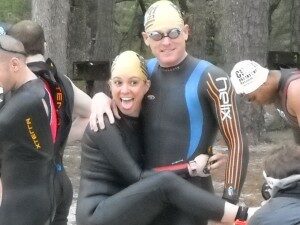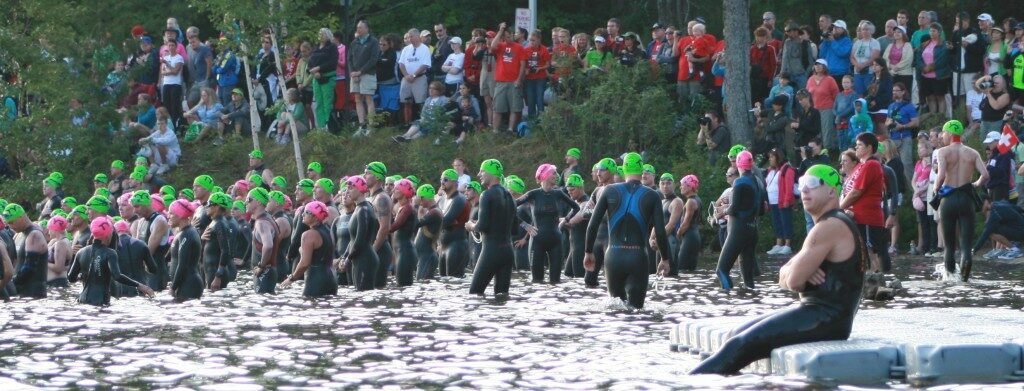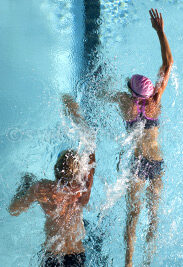You have your first triathlon – which means your first open water swimming with a big group of people. *Gulp.* In this article, we provide our top 10 triathlon swim tips to help you survive – and maybe even enjoy – your first triathlon swim.
Many triathletes do not come to the sport with a swimming background, and the process of learning to swim is challenging to both our bodies and our brains. When you add dark, open water and several hundred other athletes, it’s downright intimidating. We get it!
When I talk with someone who says they are apprehensive about their first triathlon swim experience (or even their third or tenth), I completely understand. I came to triathlon as a runner, and I remember how scary those first few experiences were. But, with time, I’ve become much more comfortable swimming open water and racing open water.
This posts offers 10 of our best triathlon swim tips for surviving (and maybe even enjoying!) your first race experience. We’ll cover some key tips for both before and during the race.
1. Train open water before the race
Preparing for your first triathlon swim should start before race day, with specific training in open water. These sessions will allow you to get used to currents, winds, and swimming in a body of water that doesn’t have a convenient black or blue line running down the middle of the course. For safety, bring a buddy or two with you.
2. Practice sighting
Both in open water and in the pool, be sure to regularly practice sighting to ensure that you are able to swim a straight line. Tip: don’t raise your head any more than you have to. When you raise your head, your legs sink. I like to sight right after I breathe. So, I finish the breath, put my head back in the water to take the next stroke, and then as I’m pulling through, I raise just my eyes above the water surface to see where I am. Others like to sight before they take a breath. To find what works for you, practice in training!
3. Test your gear
Race day is not the best day to take your wetsuit for a test drive. If you are planning to swim in a wetsuit, make sure you practice in it.
Be prepared to race in a variety of different goggles: clear, tinted, metallic, so you can be prepared for whatever the weather conditions are. If it’s sunny, you’ll want a pair of goggles that help protect against glare – and vice versa if it’s cloudy. Also, having a spare pair of goggles is handy in case something happens to your main pair race morning.
4. Visualize success
In the weeks leading up to the race, visualize the swim and your reaction to a variety of different potential scenarios: cold water, no wetsuit, choppy water, currents (if swimming in a river or tidal waterway), wave start/swimming with people, sun glare, and the like. Then, visualize your SUCCESSFUL reaction to each of these issues. If you visualize the scenario, you will help prepare an effective response to whatever may happen on race day.
5. Chafing is not your friend

Be sure to apply Body Glide (or similar product) liberally to any hot spots, such as your neck and your underarms. You will also want to apply body glide around your ankles and lower calves to make it easier to get out of your wetsuit.
6. Stay Warm
If it is chilly on race morning, make sure to stay as warm as possible. Once you catch a chill, it’s hard to get rid of it. Arrive to the race in multiple layers, and you may even want to put your wetsuit on a little early as that will keep you warmer.
7. Know the course
Make sure you know the course – does it go clockwise or counter-clockwise? Are the buoys to be kept to your left or right shoulder? Is it one loop or two loops? Understanding how the course moves also allows you to pick a starting position. Unless you have lots of open water swimming experience (which I’m guessing you don’t if you are reading this article), I recommend sticking to the back of the pack, and/or the outside of the pack (further away from the buoy line).
8. Acclimate – don’t hate
If the race is not an in-water start, I recommend either getting in the water a few minutes before to acclimate, or at a minimum, splash some water on your fast to avoid the shock of cold or cool water when you put your face in it.
In the moments before the start, concentrate on controlling your breathing. Engage in deep abdominal breathing to slow and steady your heart rate. Starting the swim with your heart rate elevated isn’t good for reducing anxiety or panic. Focus on your race plan, and visualize a successful swim start.
9. Stay calm at the start
The opening of a triathlon swim is chaotic. While not every swim start is as chaotic as the mass start of an Ironman, it is very likely you will get bumped–even if your wave contains only 50-100 people. You may get kicked. The trick is to stand your ground, and continue swimming. Work on finding your rhythm, regardless of what is happening around you.

During my first year of triathlon, I would often wait 30-60 seconds after the race started before I started swimming. This allowed me to calm myself, to watch where the other swimmers were going, and to find some open water during the beginning of the swim. If this is your first triathlon, I highly recommend doing this. You will save more time by waiting and not panicking, then by rushing into the water and risking an anxiety attack.
If you find that you experience some panic or anxiety, do your best to keep swimming. But, if that isn’t possible, then get yourself out of the way of swimming coming behind you, and gently flip on your back. Let your wetsuit hold your body, and keep your breathing steady. Avoid taking gasping breaths. Rather, work on slowing your breathing, which will get your heart rate under control.

As you begin to swim again, exaggerate the rotation allowing you to take a slightly longer and slower breath, but still keep moving forward. When you feel calmed, return to a normal stroke and keep moving forward. That’s the name of the game!
10. Settle into a rhythm
As you settle into the body of the swim, find something that will help you keep a steady rhythm. I like to count. When I breathe bilaterally, I count: “1, 2, 3/breathe; 4, 5, 6/breathe…” I will count up to 6-12 strokes, at which point I will sight. After I sight, I start back at #1. I repeat this for the duration of the swim – whether it is 1/4 mile or 2.4 miles.
Others like to use a mantra. Our friend Larry Parker once swam the Ironman Lake Placid swim repeating: “One, two buckle my shoe…Three, four, shut the door…”
No matter what method you choose to settle yourself and find your rhythm: work on breathing rhythmically and steadily. If your breathing is steady, your swim will be too.

If you are feeling brave, you might even consider drafting other swimmers, by swimming at their feet (be careful not to tap their toes – that’s annoying to the other swimmer), or by swimming with your head in line with their hip. Do not swim side-by-side, that has a negative effect on both of your speeds.
As you come into the finish of the swim, don’t stop until you feel the bottom. Once your hand grazes the bottom, you can stand. You will move more efficiently through deeper water by swimming, than by trying to run/walk through it. As you advance, you can also try dolphin diving through the shallower water, but be mindful of people around you and how shallow the area may be.
As you exit the water, flip your goggles up on your head, which will leave your hands free to begin unzipping your wetsuit. Pull the wetsuit down to your waist, so you are ready to take the rest of it off once you get to your transition area.
Smile as you run to transition – you just made it through the swim!

